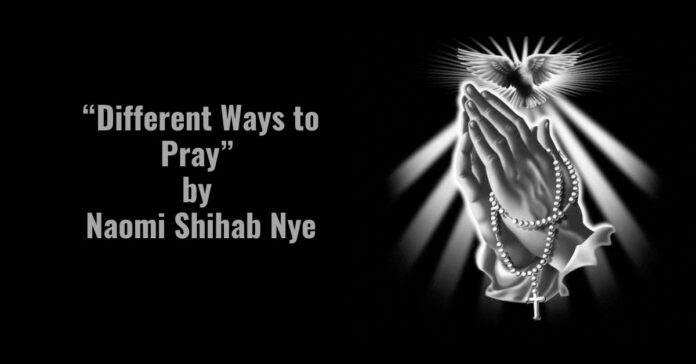“Different Ways to Pray” by Naomi Shihab Nye is a descriptive poem. Since its inception in 1995, the poem gained global acclaimed due to its universality. It revolves around the phenomenon of praying. The writer explains how prayers echo different meanings from one generation to another. She beautifully describes how men, women and children opt various ways to pray in their lives. Although they raise their hands to address the same God, yet their methods of worshipping are different. The choice they make for worship demonstrate their faith. It shows that faith can connect and differentiate between people of all ages and backgrounds.
“Different Ways to Pray” by Naomi Shihab Nye Themes
Faith, praying, multi-generation connection and trust are the major themes of the poem. Right from the start, the writer clears her intention of writing this poem. The poem begins when she describes how women choose to pray in a sophisticated and private manner. On the contrary, men choose to pray in open fields. Although they talk about the sufferings they endure in life, they also show contentment life offers them occasionally.
Similarly, there are people who travel to Mecca wearing white linen to offer their special prayers. After discussing the deep faith of religious people, the writer tends to explain the attitude of the young lads. To them, people who stick to their religion and invest a plenty of time making special prayers just waste their time. Ironically, those people are praying for the betterment of those who considered them fool. Naomi ends this poem with a touch of humour where she talks about a person named Fowzi who lives in his own world and is famous for his choices.
Different Ways to Pray” by Naomi Shihab Nye Devices
Unlike every writer, Naomi has also added various literary and poetic devices in the poem to give it a unique touch. She has used symbolism, imagery, irony and metaphor in the poem to justify her ideas about praying.
First and foremost, she has used visual and tactile imagery to let the readers imagine of what is being said in the poem. Using her intellect, she has made us think of various ways people use for kneeling such as; “The women dreamed wistfully of bleached courtyards” and “Under the olive trees, they raised their arms.”
Irony is another literary element that she has used in the later part of the poem. She describes how old and mature people offer special prayers and children pay no heed to whet they seek.
Moreover, Naomi has used prayer as an extended metaphor to show how it echoes differently in the world around. She has also added various symbols to talk about manners people opt for praying in different regions of the world.
By using these devices, Naomi has beautified connected the readers to the subject matter of the poem. Their extended use has made this poem an engrossing read.

In-depth Analysis of the Poem
Stanza#1
The first stanza of the poem introduces us to the subject matter of the poem. The writer states that there are various methods of kneeling, but there is a structured method of kneeling on a county that has smooth surface. The women of such country wish to have clean courtyards but they have not the desired place for praying. Their courtyards are not levelled up to their desires. Despite this hurdle, they make their prayers using small strong words in an infinite pattern.
Stanza#2
In the second stanza, the writer introduces us with men who are focused at walking their sheep. She states that when these men have to pray, they do not long for a separate or well decorated corner. Instead, they ask for Almighty’s help while sitting under an olive tree. Olive tree symbolizes hope, peace and health. Therefore, they purposefully choose this place, hoping to be heard by the creator. After prying, they try to thank God for the blessings they have in life.
Stanza#3
In this stanza, the speaker talks about Muslims that they go to Mecca by wearing new clothes to please the God. When they reach Mecca, they circle Ka’ba seven time and kiss the black stone afterwards. When they return, their faces exhibit mystery and depth.
Stanza#4
This stanza further talks about some people who earn peace and satisfaction while performing ordinary tasks. To them, getting water from lake or river, and trying to balance the food is same like making special prayers in Mecca because offering pilgrimage seem impossible to them. These are hardworking people who put their blood and sweat in making ends meet.
Stanza#5
Although this stanza carries the same theme, yet it has a special focus on children. To our surprise, children of those religious people are least bothered about praying or kneeling because they live in different environment. They mock the old people who spend their time in praying. Ironically, the old ones pray for their rehabilitation and protection.
Stanza#6
The final stanza of the poem seems completely odd, where the speaker talks about a person named Fowzi who has nothing to do with this praying circle. He loves beating everyone at dominos and claims that he spoke to God and goats and is famous for his laugh.
See Also:
“Famous” by Naomi Shihab Nye Analysis
Review of the Book “The Archer”










